Okayama University
| Okayama University | |
|---|---|
 Okayama University Library (Tsushima Campus) | |
| Motto | "Creating and fostering higher knowledge and wisdom" |
| Established | Founded 1870 Chartered 1922 |
| Type | Public (National) |
| President | Kyozo Chiba |
| Academic staff | 1,402 full-time |
| Admin. staff | 1,201 |
| Students | 14,035 |
| Undergraduates | 10,567 |
| Postgraduates | 3,468 |
| Doctoral students | 1,343 |
| Location | Okayama, Okayama, Japan |
| Campus | Urban |
| Colors | Blue and Red ocher |
| Website | www.okayama-u.ac.jp |
Okayama University is a national university in Japan. The main campus is located in Tsushima-Naka, Okayama, Okayama Prefecture.
The school was founded in 1870 and it was established as a university in 1949.
History
The origin of the university is the Medical Training Place founded in 1870 by Okayama-Han. It underwent the abolition of the han system and was developed into Okayama Prefectural Medical School in 1880. In 1888 it was merged into a national school, the Third Higher Middle School to constitute the Medical Faculty. The Medical Faculty became an independent school in 1901 and was renamed Okayama Medical Speciality School ( Okayama igaku semmon gakkō), a four-year medical school for men at ages 17-21 or above. In 1922 the school was chartered as Okayama Medical College ( Okayama ika daigaku), a four-year medical college for men at ages 19-23 or above.
In 1949, after World War II, the college was merged with other national and public colleges in Okayama Prefecture to establish Okayama University, under Japan's new educational system. The predecessors of the university were Okayama Medical College, the Sixth Higher School , Okayama Normal School , Okayama Youth's Normal School and Okayama (Prefectural) Agricultural College .
The new campus (Tsushima Campus) was the former camp of the Imperial Japanese Army (the 17th Division). After occupation army left the camp (in 1947), the students of the Sixth Higher School (whose buildings were burnt in the war) guarded the camp, residing in the former military barracks. They finally got the camp as their campus. The faculties of Okayama University, except the Medical School, were gradually removed to Tsushima Campus.
The university at first had five faculties: Law and Letters, Education, Science, Agriculture and Medicine. The latter history of the university is as follows:
- 1951: Ohara Institute for Agricultural Research joined the university.
- Later reorganized into the Institute for Agricultural and Biological Sciences (in 1953) and then the Research Institute for Bioresources (in 1988).
- 1960: the Faculty of Engineering was established.
- 1967: Professor Jun Kobayashi (analytic chemistry, Faculty of Agriculture) announced the cause of Itai-itai disease as cadmium poisoning. Itai-itai disease (meaning "ouch ouch" disease in Japanese), was a severe pain disease affecting Toyama Prefecture as a result of mining over the course of 1,500 years.
- 1976: the Faculty of Pharmaceutical Sciences was established.
- 1979: the Dental School was established (in Shikata Campus).
- 1980: the Faculty of Law and Letters was divided into three faculties: Letters, Law and Economics.
- 1994: the Faculty of Environmental Science and Technology was established.
Faculties (Undergraduate Schools)
- Faculty of Letters
- Department of Humanities
- Faculty of Education
- Training Course for School Teachers
- Training Course for School Nurse Teachers
- Faculty of Law
- Department of Law (including Evening Course)
History
In 1949, Okayama University set up the department of law, economics and literature at the same time as the University was founded. In those days, this was the only faculty of law in the region of Chugoku and Shikoku. Later in 1980, Okayama University reorganized the department and separated the faculty of law which became the department of law today. Then, in 2004, Okayama University reorganized again when the law graduate course was established. As a result, there are both daytime courses and nighttime courses in the faculty of law. The law department continues to be a base of education, law and politics. During 50 years, the University has produced many great person in various field, especially the judicial world.
Educational Aims
The faculty of law aims at educating people who can deeply understand and analyze modern society and who have the ability of logic and application. To be concrete, 1, people who can gain a basic knowledge about each law field and who can solve problems logically with their legal mind. 2, people who understand various view about politics and society and have a curiosity and ability to solve problems in current society. 3, people who understand about international society and have communication skills and can we deal with information well.
What is a legal mind?
Study in the department of law is mainly founded on law. But students also develop the texts of law and the knowledge of system and thinking skills in order to cope with the various problems which really occurs in society. In addition, students will develop a legal mind in this faculty . Such students can clearly analyze legal problems and quickly solve a variety of such issues.
Discover to solve and problems in current society
On lectures about professional fields of law and politics, people study basic knowledge and basic ways of thinking. In addition, student can take small class, seminar. They can develop the ability of arguing, thinking deeply and discovering problems. Moreover they can improve their personality.
In order to learn communication ability and information use ability
Thought many small seminars, students are challenged to think deeply and improve their problem solving ability.
Connection to business
In the department of law, students learn from actual problems which have occurred in society. In addition, use in discovery of the problem in the result of education research of the University society and survey of solution method, students are advancing the people and the cooperation which participate to business.
- Faculty of Economics
- Department of Economics (including Evening Course)
Modern Economic Analysis
The students of this Course learns macro and micro economics and their trends, that is, to figure out structures and movements from theoretical, empirical (statistical), and strategic points of view by taking this course. Students can better understand the contents of newspapers and economic magazines, and furthermore, interpret economic survey data of the government.
International Comparative Economics
In this course, students learn about the current economic states of major countries or regions in order to make comparisons and analyses of them, as well as each country’s economic development and history. The students of this course learn basic knowledge that is very useful to work for multinational companies in many fields, including the manufacturing, trading, or service industry.
Management and Accounting
Students who take this course work in administration, including management, organization, and strategy, and in accounting and financing, Students come to understand and develop insights into actual company operations. This course has students who want to be a certified public accountant or a licensed tax accountant.
- Faculty of Science
- Department of Mathematics
- Department of Physics
- Department of Chemistry
- Department of Biology
- Department of Earth Sciences
- Medical School (in Shikata Campus)
- Faculty of Medicine
- Faculty of Health Sciences
- Department of Nursing
- Department of Radiological Technology
- Department of Medical Technology
- Dental School (in Shikata Campus)
- School of Dentistry
- Faculty of Pharmaceutical Sciences
- Department of Pharmacy
- Department of Pharmaceutial Technology
- Faculty of Engineering
- Department of Mechanical Engineering
- Department of Applied Chemistry
- Department of Electrical and Electronic Engineering
- Department of Information Technology
- Department of Bioscience and Biotechnology
- Department of Systems Engineering
- Department of Communication Network Engineering
- Faculty of Environmental Science and Technology
Environmental science and technology has four departments: Environmental and Mathematical Sciences, Environmental and Civil Engineering, Environmental Management Engineering, and Environmental Chemistry and Materials.
The environmental science and technology faculty began in 1995. The faculty was established to create knowledge that is a fusion of the natural, health and cultural sciences. This is the first university in Japan where such a special knowledge of environment is studied so many universities and companies have a special interest in this department.
Environmental problems are seriously influencing the world. This faculty is contributing to solving these problems, and practicing a number of important projects. For example, an environmentally-friendly resource recovery process using waste nickel hydride battery project; risk management security strategies for toxic substance disposal; advanced nano materials fullerene project; full color rewritable paper using functional capsules; ecological genetic study of clock genes that can cause speciation project.
- Faculty of Agriculture
- Department of Agricultural Sciences
- Matching Program Course
-
- This course is designed to help students create their own integrated program matching individual career interests and goals with what they study. Each student will decide an area of interest and investigate it. Choices will not be limited to the existing curriculums offered by faculties and departments. The goal is to develop students' character as well as ability. Okayama University will award a bachelor's degree in "Philosophy" to those students who complete the matching program course.
-
- This course needs students who have inquiring minds about many things and to research about it themselves. So they have to do a lot of unique examinations the below example. The course will train people who want to have a job on the international stage therefore the students have original English classes in the course and the teachers support students to go abroad to study English. Students can take many lectures which they want so students can develop their thinking skills.
-
- Entrance examination
-
- In Japan, almost all university entrance tests have written form. But in this course, there are four parts as entrance exams:
- First of all, the candidates have to take two lectures and to write a report on each of them about the assignment which is given by teacher.
- Second, they should write a short essay, from a choice of six themes; mathematics, chemistry, physics, biology, earth science and sports. And at the same time, candidates have to make a poster to use after next part.
- Third, they have to do the presentation about the poster and every candidate has 5 minutes to show it in front of everyone including the teachers. After the presentations, they have a discussion about their presentation for about 20 minutes.
- The last part of the examination is an individual interview. This lasts approximately 15 minutes, and candidates are asked about not only themselves but also the examination such as the presentation and the discussion.
- Many candidates feel it is a very tough exam but they can have a very good experience through the exam.
-
- History and Now
-
- The matching Program course in Okayama University started from 2006, and now 47 students belong to three grades of the course. Almost all students in the university can’t have their room, and they can take classes from only their faculty. Besides they could not change their faculty if they feel somewhat out of place for their major. On the other hand students in MP course can have their own desk and computer until the second grade.
-
- Students can take classes from other faculties which they are interested in and some original classes in this course. So students can decide their major after thinking through many experiences. These reasons are why The MP course is so good and unique.
-
- Now there are some interesting lesson in this course. One of the original lessons is “MP seminar”. In this class students study many topics from various departments and practice to share their thinking through presentations. So students can learn to make good PowerPoint and can get used to present in front of an audience.
Graduate Schools
- Graduate School of Education (Master's courses/Professional Degree Course)
- Graduate School of Humanities and Social Sciences (Master's/Doctoral)
- Graduate School of Natural Science and Technology (Master's/Doctoral)
- Graduate School of Health Sciences (Master's/Doctoral)
- Graduate School of Environmental Science (Master's/Doctoral)
- Graduate School of Medicine, Dentistry and Pharmaceutical Sciences (Master's/Doctoral)
Attached Institute
- Research Institute for Bioresources
Nationwide Joint-use Facility
- Institute for Study of the Earth's Interior
Campus
Each campus is located in central part of Okayama-city, excepting the Misasa Campus
Tsushima Campus
Tsushima Campus has Administrative Center.
- Address:1-1,Tsushima-Naka,1-chome, Okayama/1-1,Tsushima-Naka,2-chome, Okayama/1-1,Tsushima-Naka,3-chome, Okayama/1-62,Tsushima-Kuwanokicho, Okayama
Shikata Campus
- Address:5-1,Shikata-cho,2-chome, Okayama
Misasa Campus
- Address:827,Yamada, Misasa,Tottori Prefecture
Location


University Hospital
Clinical Divisions (Medicine)
- General Internal Medicine
- Gastroenterology
- Hematology and Oncology
- Allergy and Respiratory Medicine
- Nephrology,Diabetology and Endocrinology
- Rheumatology
- Cardiovascular Medicine
- Neurology
- Infectious Disease
- Gastroenterological Surgery
- Hepato-biliary and Pancreatic Surgery
- Respiratory Surgery
- Breast and Endocrine Surgery
- Urology
- Cardiovascular Surgery
- Orthopedic Surgery
- Plastic Surgery
- Dermatology
- Ophthalmology
- Otorhinolarygology
- Neuropsychiatry
- Neurological Surgery
- Anesthesiology & Resuscitology
- Pediatrics
- Child Neurology
- Obstetrics & Gynecology
- Radiology
- Emergency Medicine
- Anatomic Pathology
Clinical Divisions (Dentistry)
- Comprehensive Dentistry
- Operative Dentistry
- Periodontics and Endodontics
- Fixed Prosthodontics
- Occlusion and Removable Prosthodontics
- Oral and Maxillofacial Surgery and Biopathology
- Oral Diagnosis and Dentomaxillofacial Radiology
- Dental Anesthesia
- Orthodontics
- Preventive Dentistry
- Pediatric Dentistry
Hospital Pharmacy
Division of Nursing
Medical Support
Central Clinical Facilities
- Central Clinical Laboratory
- Central Division of Surgery
- Central Division of Radiology
- Intensive Care Unit
- Physical Medicine & Rehabilitation
- Perinatal Center
- Division of Anatomic Pathology
- Division of Emergency Medicine
- Division of Blood Transfusion
- Division of Chronic Respiratory Diseases
- Center of Gene and Cell Therapy
- Central Division of Anesthesia
- Cardiac Care Unit
- High Care Unit
- Division of Hemodialysis
- Division of Endoscopy
- Division of Nuclear Medicine
- Division of Extracorporeal Shock Wave Lithotrispy
- Division of Clinical Dietary
- Cancer Center
- General Clinic for Special Disorders
- General Diagnostic Unit
- Division of Dental Laboratory
- Division of Dental Hygienist
Clinical Support Department
- Division of Medical Informatics
- Integrated Support Center for Patients and Self-learning
- Supply, Processing and Distribution Center
- Medical Engeneering Center
Medical Safety Department
- Division of Medical Safety Management
- Division of Infection Control
- Division of Safety Management of Medical Instruments
The Center of Clinical Research of New Drugs and Therapeutics
Post Graduate Clinical Education Center
Central Research Laboratory
Misasa Medical Center
Administration Office
Central Library
Central Library Maps
Main Building 1F,2F,3F
New Building 1F,2F,3F,4F ,5,6F
Main Buiding 1F
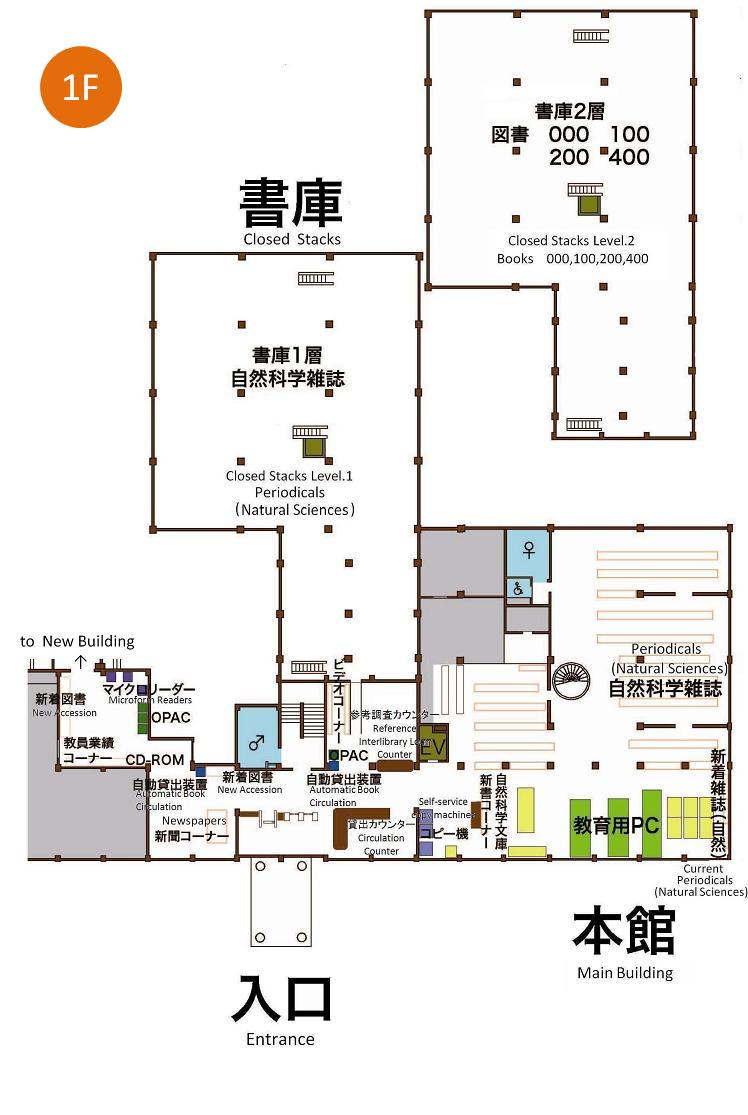
Main Buiding 2F
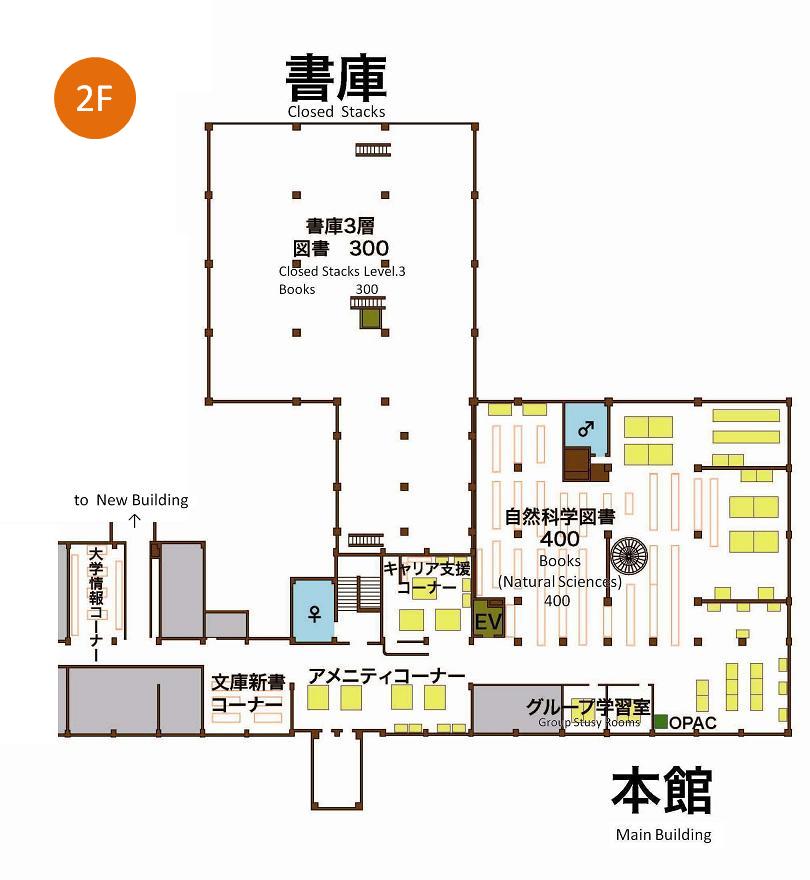
Main Buiding 3F
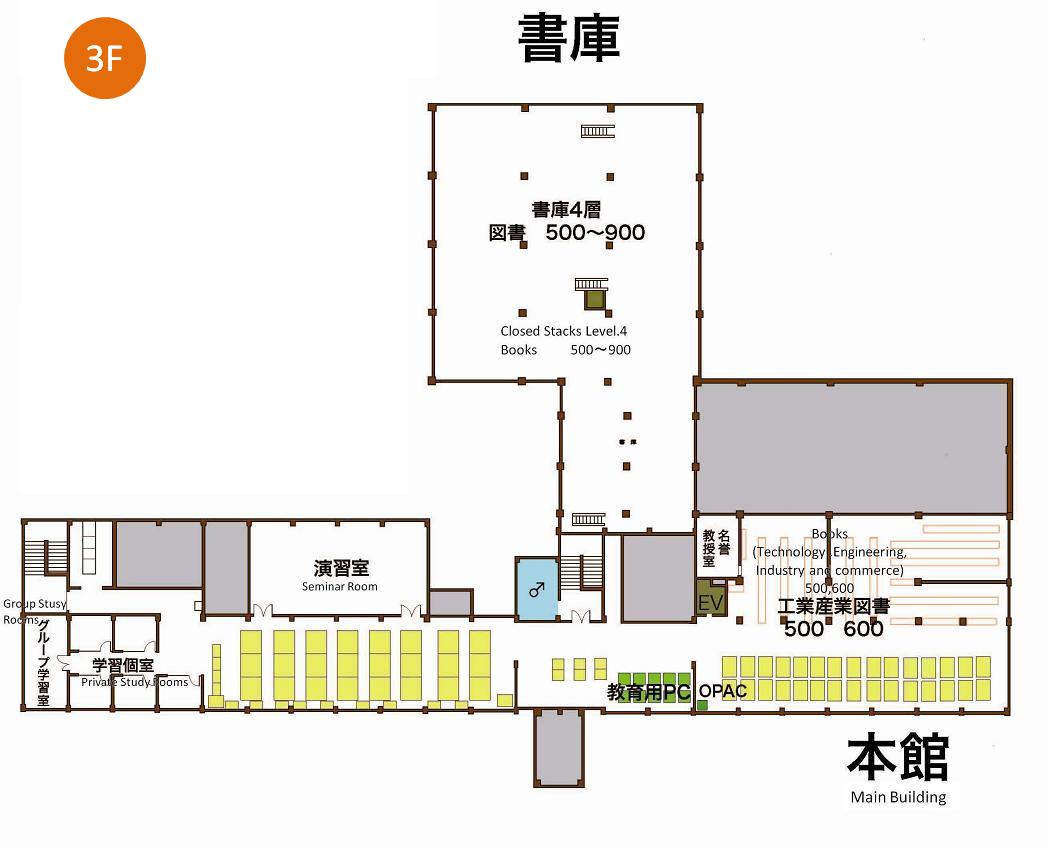
New Buiding 1F
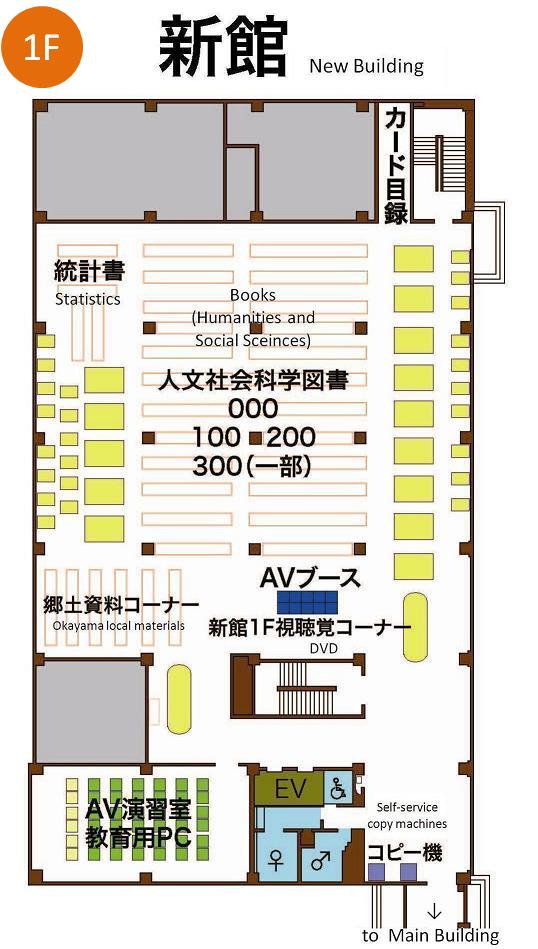
New Buiding 2F
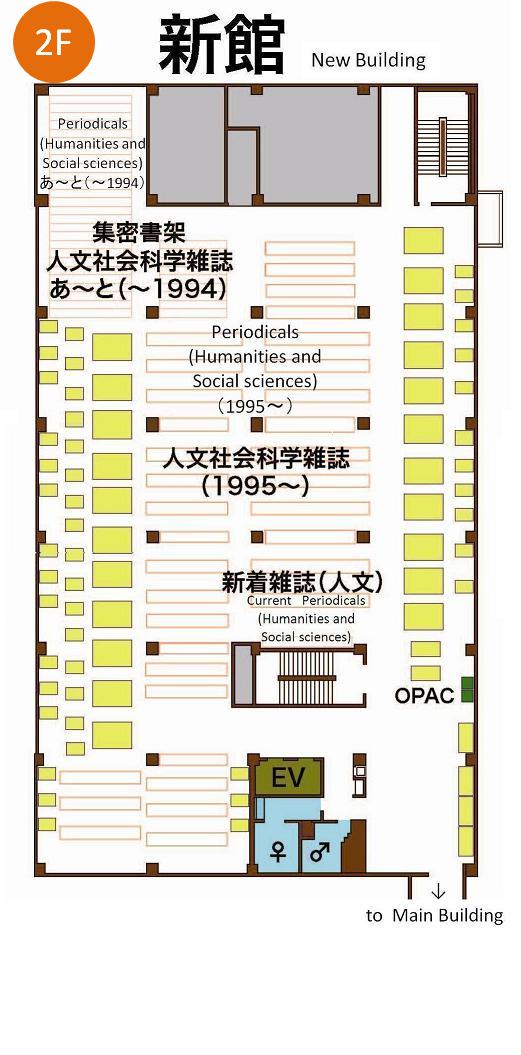
New Buiding 3F
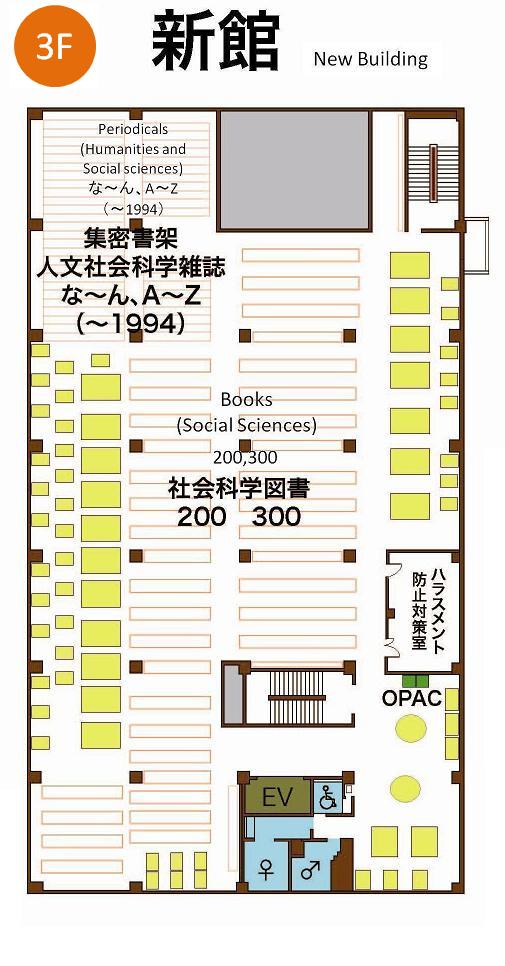
New Buiding 4F
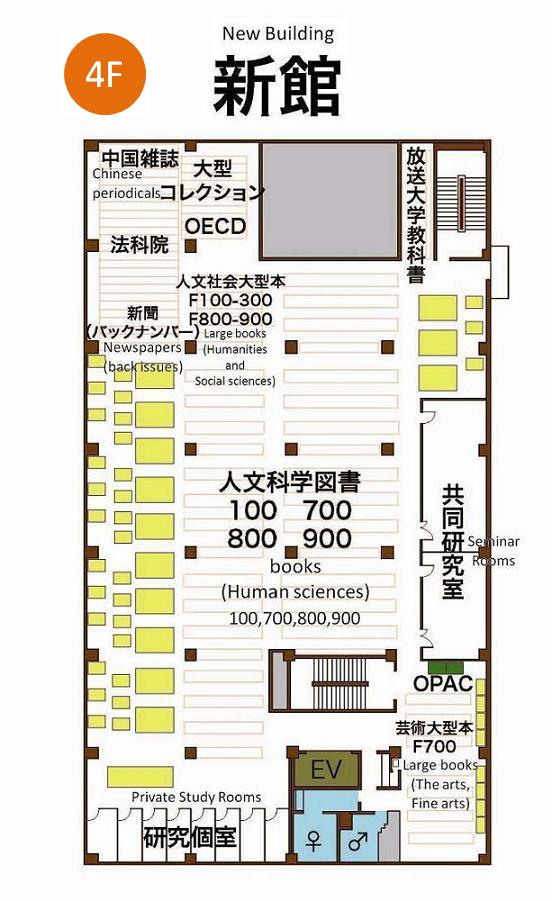
New Buiding 5.6F
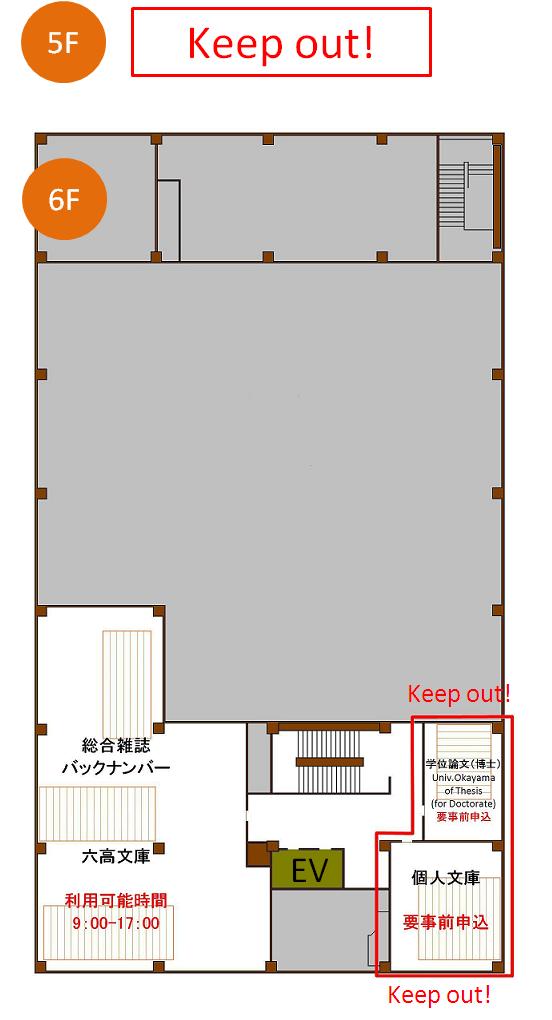
A Guide to Okayama University Central Library -for Students
Attention
-Eating and smoking are prohibited in the library.
-Please go to the Amenity Corner on the 2F in the main building for drinking.
-Speaking on a mobile phone is permitted only cellullar phone booth* in the library.
*Cellular phone booth are located on the 1F in the main building, 3F in the main building and 2F in the new building.
-Please return the materials to original locations after using.
-Please don't park your bicycle around the entrance of the library.
Issuing a library card
To borrow materials you need a library card to use the library.You can use your Student ID card(with an IC chip) as Library Card. If you don't have a Student ID card(with an IC chip),the library will issue a Library Card.*
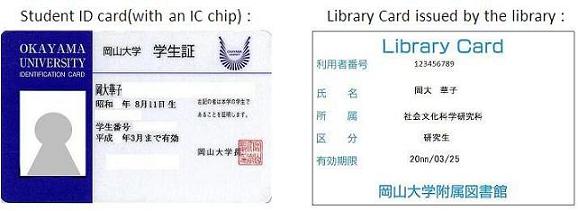
If you belong to Tsushima campus, please come to the main couter of Central Library.
*You can use the Card in Shikata branch library, too.
Library Hours
| Mon. Fri. | Sat.&Sun. | |
|---|---|---|
| Regular hours | 8.40 23.00* | 10.00 18.00 |
| Vacations | 9.00 17.00 or 9.00 19.00 | Closed |
For details, please check the Library Hours.
Closed days
-Saturdays and Sundays during vacations-National holidays during vacations
-Year-end and New Year Holidays
-Close hours
※For details, please check the Library Hours.
Entrance and exit
Entrance
When you enter the library, Student ID card(with an IC chip) or Library card is required.You can enter the library after your ID card or Library card is recognized by the card reader at the entrace gate.
Please ask the main counter, when you forget the cards.
Exit
Please go through the exit gate, when you leave the library. If the alarm sounds, follow the instructions of the staff.Location of materials
Please look at the floor map.How to find materials
When you want to find books or periodicals in the collection of the Okayama University, please use Online Public Access Catalog(OPAC).Materials in Stack room
There is limit to go into the stack room.If you want to use the materials located in stack room, plese make your request at the main couter with "Request from for materials located in Stack room"(pink sheet).
No service on Saturday and Sunday.
Graduate or senior undergraduate : you can apply for permission to enter the stack room to main counter.(Mon.-Fri, 9:00-16:45)
Borrowing and returning
Loan period and number
Undergraduate students
| Books | Periodicals | |
| Loan period | 2weeks | 3days |
| Number | Up to 10(Including periodicals) | |
| Books | Periodicals | |
| Loan period | 2weeks | 3days |
| Number | Up to 15(Including periodicals) | |
Non-Circulating materials
a. Rare materialsb. Current periodicals
c. Reference books
d. Newspapers
e. Most audio-visual materials
Borrowiong
The user who wishes to borrow materials requires student ID card or Library card.a. Please present your Student ID card or Library card and the materials you wish to check out at main counter.
b. Automatic Book Circulation is available for materials with the barcodes and Student ID card(with IC chip).
Renewal
When you wish to renew the borrowing period of the book, you can renew from My library (web request).You can also renew the borrowing period at the main couter, please present your Student ID or Library card and the book you wish to renew.
Renewal is up to once.
The following books cannot be renewed:
-Books that are overdue
-Books that have been reserved by someone else
-Periodicals
-A part of materials*
*Books often used in lectures...etc.
Borrowing for writing thesis
If you are graduate student or senior undergraduate student, you can borrow another 20 materials for writing thesis.To use tihs service, you need another Card issued by the library.Please apply to main counter(Mon.-Fir.9:00-17:00)
| Loan Number | Up to 20 |
|---|---|
| Loan period | the end of February, the current year |
Return
| Library open | Please put the materials you wish to return on the returning corner of the main counter. |
|---|---|
| Library closed | A book-drop at left side of the entrance is available. Don't drop the CDs. |
Overdue/Penalty
If you have not returned by period, you can't borrow and renew any materials for the same period you have overdue. (a maximum of 1 month.)Reservation
If you would like to borrow a book that is presently showed "in circulation" on OPAC, it is possible to reserve the book by using My library .When the reserved materials returned, the information will be send to G-mail.*
*G-mail address provided by Okayama-University.
For details, click here.
Use of Electronic Journals and Database
User can access only incampus.Please access the website of the library and click Electronic Periodical/databaselist.
On using Electronic Periodicals, please confirm Attention Section located on the top of the page.
Photocopying
Comply with the Copyright Law when you use this service.The materials only in this library can be copied. Library materials can be photocopied for the purpose of your own investigation or research within the limits of copyright laws.
Before you photocopy the materials, please fill in the Photocopy application form.
There are photocopiers for coins and photocopiers for prepaid cards (Co-op)in the library.
Photocopiers are at the following location.
| Photocopiers for conis | 1F in Main Bldg. |
|---|---|
| Photocopiers for prepaid cards | 1F in Main Bldg. 1F in New Bldg. |
Interlibrary Loan
Materials not on Tsushima campus may be borrowed or gotten photocopy from other libraries.You must pay all the costs.
Please request at the Service Desk with the form Yellow sheet for Borrowing,Blue sheet for Photocopying (public expense),White triple sheet for Photocopying (private expense) .
You can receive photocopy until 5 pm on Mon-Fri at the Service Desk.
You may go to other libraries and use materials held by them.
Please ask us before more than a week you want to go.
Facilities
PCs
PCs are available in the library for information retrieval and document creation.PCs are at the following location.
- 1F in the Main Bldg.
- 3F in the Main Bldg.
- 1F in the New Bldg.
PCs can be used freely during the service hours of library.You need an account issued by Center for Information Technology and research.
You can use PCs only for purpose of study and research.
OPAC(Online Public Access Catalog)
- 1-3F in the Main Bldg.- 2-4F in the New Bldg.
Private study rooms,Group study rooms
| Facilities | Location |
|---|---|
| Private sutudy room 1-5 | 3F in the Main Bldg. |
| Private sutudy room(for graduate) 1-8 | 4F in the Main Bldg. |
| Group sutudy room 1-3 | 2,3F in the Main Bldg. |
A Guide to Okayama University Central Library -for Faculty & Staff
Attention
-Eating and somking are prohibited in the library.
-Please go to the Amenity Corner on the 2F in the main building for drinking.
-Speaking on a mobile phone is permitted only cellular phone booth* in the library.
*Cellular phone booth are located on 1F and 3F in the main building, 2F in the new building.
-Please return the materials to the original locations after using.
-Please don't parking your bicycle around the entrance of the library.
Issuing a library card
To borrow materials you will need a library card.You can use your Staff ID card(with an IC chip) as Library Card.Staff ID card (with an IC chip) is the one with magnetic stripe on the back.If you don'thave a Staff ID card(with an IC chip),the library will issue a library card.
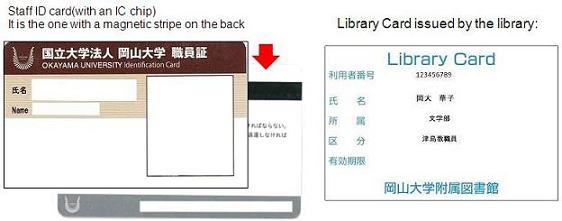
If you belong to Tsushima campus,please come to the main couter of Central Library.
(※You can use the card in Shikata branch library, too.)
Library Hours
| Mon.-Fri. | Sat.&Sun. | |
|---|---|---|
| Regular hours | 8.40-23.00 | 10.00-18.00 |
| Vacations | 9.00-17.00 or 9.00-19.00 | Closed |
For details, please check the Library Hours.
Closed days
-Saturdays and Sundays during vacations-National holidays during vacations
-Year-end and New Year Holidays
-Close hours
※For details, please check the Library Hours.
Entrance and exit
Entrance
When you enter the library, Staff ID card(with an IC chip) or Library card is required.You can enter the library after your ID card or Library card is recognized by the card reader at the entrace gate.
Please ask the main counter, when you forget the Cards.
exit
Please go through the exit gate, when leave the library.If the alarm sounds, follow the instructions of the staff.Location of materials
Please look at the floor map.How to find materials
When you want to find materials in the collection of the Okayama University, please use Online Public Access Catalog(OPAC).Materials in stack room
There is limit to go into the stack room.Faculty and staff can apply for permission to enter the stack room to main counter.(Mon.-Fri.,9:00-16:30)
Or plese make your request at the main counter with "Request form for materials located in Stack room"(pink sheet).
No service on Saturday and Sunday.
Borrowing and Returning
Loan period and number
| Books | Periodicals | |
| Loan period | 2weeks | 3days |
| Number | Up to 30(Including Periodicals) | |
Non-Circulating materials
a. Rare materialsb. A part of periodicals (current periodicals etc.)
c. Reference books
d. Newspapers
e. Most audio-visual materials
Borrowiong
The user who wishes to borrow materials requires Staff ID or Library card.a. Please present your Staff ID or Library card and the materials you wish to check out at main counter.
b. Automatic Book Circulation is available for materials with the barcodes and Staff ID(with IC chip).
Renewal
If you want to use the borrowed book continuously, it can be renewed.Please present your student ID card and the books you wish to renew at the main counter.Renewal is up to once.
The following books cannot be renewed:
-Books that are overdue
-Books that have been reserved by someone else
-Periodicals
-Reserved Book
Return
| Library open | Please put the materials you wish to return on the returning corner of the main counter. |
|---|---|
| Library closed | A book-drop at left side of the entrance is available. Don't drop the CDs. |
Overdue/Penalty
If you have not returned by your date, you can't borrow and renew any materials for the same oeriod you have kept the materials overdue.(a maximum of 1 month.)Use of Electronic Journals and Database
User can access only incampus.Please access the website of the library and click Electronic Periodical/databaselist.
On using Electronic Periodicals, please confirm Attention Section located on the top of the page.
Photocopying
Comply with the Copyright Law when using this service.The materials only in this library can be copied. Materials possessed by the library can be photocopied for the purpose of your own investigation or research within the limits of copyright law.
Before you photocopy the materials, fill in the Photocopy application form.
Private expense
There are photocopiers for coins and photocopiers for prepaid card (Co-op) in the library.
Photocopiers are at the following locaton.
| Photocopiers for coins | 1F in the Main the Main Bldg. |
|---|---|
| Photocopiers for prepaid cards (Co-op) | 1F in the Main the Main Bldg.,1F in the New Bldg. |
Copying by public expense is required Copy Card issued by the Library.Please apply at reference counter.(Service hour:Mon.-Fri. 9:00-17:00)
If you already have the card, you can use the photocopiers by public expense.
Interlibrary Loan
Materials not on Tsushima campus may be borrowed or gotten photocopy from other libraries.You must pay all the costs.
Please request at the Service Desk with the form Yellow sheet for Borrowing,Blue sheet for Photocopying (public expense),White triple sheet for Photocopying (private expense) .
You can receive photocopy until 5 pm on Mon-Fri at the Service Desk.
You may go to other libraries and use materials held by them.
Please ask us before more than a week you want to go.
Facilities
Private study room:4F New Bldg
You can use thease rooms to research or study there with library materials.(Once a day, within 4 hours)Please apply at the main couner.If you want to renew using period please ask at the main counter.
Seminar Room
| Facilities | Location | Capacity |
|---|---|---|
| Seminar room 1 | 4F New Bldg. | 10 |
| Seminar room 2 | 4F New Bldg. | 20 |
| Seminar room 3 | 3F Main Bldg. | 40 |
How to pay for a book with your public research fund
The following are purchasing steps.Placing an order → Delivery & Receipt → Check & Acceptance → (Cataloging) → Payment
- You can place an order with a bookseller for a book you need. You can also ask the library to give the bookseller an order for it.
- After the book arrives, the library checks the condition, price, etc. When the book is acceptable, the library stamps on it and sends it to you.
- You need to enter your public research fund information into the web system*.
* http://www.okayama-u.ac.jp/user/kouhou/gakunai/kounyu/kounyu-index.html (Japanese only)
- When the book is available for years, the book is need to be managed in the same way as the university assets. In this case, the library catalogs the book and rents it to you.
- The library makes arrangements for the payment.
Journal Subscription
To order journal annual subscription, we have a journal subscription inquiry once a year (on June or July). Please submit its form before the deadline. There is some possibility that you are not able to start or cancel subscription in the middle of a fiscal year.In the case of newspaper subscription, each division arranges it, so please contact accounting staff.
Request for the purchase of materials for the library collection
- An application is made in a prescribed form.
- The library verifies whether the requested materials meet the library selection criteria or not.
- The library notifies you of the library decision.
- Materials in syllabus are basically purchased by the library before new semester starts.
- When the materials arrive, the library catalogs them and adds them to the library collection.
University-wide Centers
- The Quality Assurance Center
- Health Service Center
- Environmental Management Center
- Center for Information Technology and Management
- Center for Faculty Development
- Language Education Center
- Interactive Sport Education Center
- Career Development Center
- Student Support Center
- Admission Center
- International Center
- Center for Teacher Education and Development
- Advanced Science Research Center
- Center for the Development of Medical and Health Care Education
- Solid Waste Management Research Center
- Archaeological Operation Center
Research
Faculty Memeber Information
Search by Research Field
All display non-display
 General Area
General Area  Compound New Area
Compound New Area  Human Science
Human Science  Social Science
Social Science  Mathematics and Physics System Science
Mathematics and Physics System Science  Chemistry
Chemistry  Engineering
Engineering  Biology
Biology  Agriculture
Agriculture  Medical, Dental, and Pharmaceutical Science
Medical, Dental, and Pharmaceutical Science
Search by Affiliation
All display non-display
- Administrative Center
 Faculty of Letters
Faculty of Letters  Faculty of Education
Faculty of Education  Faculty of Law
Faculty of Law  Faculty of Economics
Faculty of Economics  Faculty of Science
Faculty of Science  Medical School
Medical School  Dental School
Dental School  Faculty of Pharmaceutical Sciences
Faculty of Pharmaceutical Sciences  Faculty of Engineering
Faculty of Engineering  Faculty of Environmental Science and Technology
Faculty of Environmental Science and Technology  Faculty of Agriculture
Faculty of Agriculture  Graduate School of Education
Graduate School of Education  Graduate School of Humanities and Social Sciences
Graduate School of Humanities and Social Sciences  Graduate School of Natural Science and Technology
Graduate School of Natural Science and Technology  Graduate School of Health Sciences
Graduate School of Health Sciences  Graduate School of Environmental Science
Graduate School of Environmental Science  Graduate School of Medicine, Dentistry and Pharmaceutical Sciences
Graduate School of Medicine, Dentistry and Pharmaceutical Sciences  School of Law(Professional Degree Course)
School of Law(Professional Degree Course) - Postgraduated Study Course of Special Education
- Special Course for School Nurse Teachers
 Research Institute for Bioresources
Research Institute for Bioresources - University Hospital of Medicine and Dentistry
- The Quality Assurance Center
- Health Service Center
- Environmental Management Center
- Center for Information Technology and Management
- Center for Faculty Development
- Foreign Language Education Center
- Interactive Sport Education Center
- Student Support Center
- Admission Center
- Career Development Center
- International Center
- Center for the Development of Medical and Health Care Education
- Advanced Science Research Center
- Solid Waste Management Research Center
- Archaeological Research Center
- Institute for Study of the Earth's Interior
- Organization for Education and Student Support
- Organization for Research Promotion & Collaboration
- University Libraries
- Research Core for Interdisciplinary Sciences
- Strategic Office for Education and Research
- Research Core for Extreme Quantum World
- Center for Teacher Education and Development
- Academic and General Okayama University Regional Research Association
Campus Life, Daily Life
University Calendar
|
|
Tuition Fee, Admission Fee, Application Charge As of 2005
| Category | Tuition Fee (yen/annual) | Admission Fee | Application Fee |
| Undergraduate Student | \535,800 | \282,000 | \17,000 |
| Graduate Student | \535,800 | \282,000 | \30,000 |
| Research Student | \29,700 (Monthly) | \84,600 | \9,800 |
| Auditor | \14,800/1 credit | \28,200 | \9,800 |
Tuition/Admission Fee Exemption
Full-time degree-seeking undergraduates and graduate students who have brilliant academic records and yet have difficulties in continuing academic works because of financial destitution might be exempted from paying the total or half amount of the tuition and admission fees. After their application, the University judges whether they are worth being exempted. Non-degree-seeking students such as research students, auditors, and special students that receive scholarship from their own government are excluded of this exemption.
For more detailed information, check the bulletin board.
※Office in charge: Student Services Division, Academic Affairs Department
086-251-7211
086-251-7211
Scholarship
Scholarships for privately financed students are as follows. (As of 2007)
We will let students know when we get information on other scholarships not listed below.
We will let students know when we get information on other scholarships not listed below.
| Name of Scholarship or Providing Group | Time of Application | Monthly Amount (yen) | Providing Period | Qualification Requirement |
| Honors Scholarship for Privately Financed International Students | May | Undergraduate \50,000 Graduate \70,000 | 1 year | |
| Okayama University International Exchange Fund Scholarship | June & November | \30,000 | 6 months or 1 year | New students from foreign countries |
| Okayama-ken International Student Scholarship | May | \20,000 | 1 year | |
| WESCO Foundation | April | \50,000 | 1 year | Students majoring natural sciences |
| Okayama Rotary International Exchange Fund | November | \100,000 (single payment) | ||
| Kobayashi Scholarship Fund for International Students | May | \40,000 | 2 year | |
| Sagawa Fund for International Students | April | \100,000 | 2 year | Students from East Asian countries |
| Jin-nai Scholarship for International Students | April | Graduate \100,000 | shortest years required for graduation | |
| Hashiya Foundation | April | \100,000 | 2 year | Students from Indonesia |
| Yoneyama Rotary Scholarship | August through September | Undergraduate \120,000 Graduate \150,000 | No longer than 2 year |
Japanese Language Education
International Student Center provides the following Japanese language class for international students.
- Japanese Language Training Course
- Japanese Language Course -Open to all international students on campus
- Preliminary Education for the Japan-Korea Joint Exchange Program for Undergraduate Students in Science and Engineering
- Japanese Language Course is open to all international students on campus. There are six class levels from Beginners I to Intermediate II. Each course lasts 15 weeks starting in April and October.
Extracurricular Activities
Okayama University has a lot of cultural and athletic clubs and circles. Joining one gives you a chance to get acquainted with Japanese students and it would make your campus life more fruitful.
※Office in charge: Student Services Division, Academic Affairs Department
086-251-7183
086-251-7183
Follow-up Technical Publication Donation
Japan Student Services Organization (=JASSO) sends research materials such as journals and research bulletins published by an academic society to international students who were enrolled in a graduate school and returned to their country to serve at educational and /or research institutions so that they can continue to pursue their research. The service lasts for two years and is free of charge.
Please submit application forms to International Affairs Office within one month from your graduation (completion).
Health Care
○National Health Insurance
Foreigners who stay in Japan more than one year have to be enrolled in National Health Insurance. Applications are accepted at the municipal office of the city, town or village where you live. You have to pay for insurance every month, but the amount depends on your income. For more detailed information, ask the municipal office. When you go to hospitals or clinics because of illness or injury, you pay only 30% of the medical fees there. 70% of the medical fees is covered by the government insurance. In the case you paid the medical fee at the medical institution which accepts National Health Insurance, some amount of your payment is reimbursed by the Japan Student Sciences Organization (=JASSO)
○Periodical Medical Check
Health & Environment Center of Okayama University provides medical check twice a year (April and October). All the international students have to take the check at the time of enrollment. The center issues the health certificate free of charge only for those who had medical check there. As for detailed information, check the bulletin board at the International Student Office and each faculty & graduate school.
Housing
○Dormitory for International Students & Researchers
Okayama University has a dormitory for international students. This dormitory is for unaccompanied international students. They can live in the dormitory for one year from their entrance to the university. But, if there are too many applicants for its capacity, the tenants are selected by lottery. Applications are accepted in February for April move-in, and in August for October move-in. If you want to apply for it, come and ask International Student Office for more information. Name, Address and Telephone Number Name: Okayama University Dormitory for International Students & Researchers Address: 6-1 Tsushima-kuwanoki Cho, Okayama 700-0084 Telephone Number: 086-251-7052 Lodging Facilities | Block | Type | Sex | Numbers of Rooms | Common Facilities | Room Equipments |
| North Wing | Student | Male | Laundry room (1st floor), Store room, Kitchen and Dining room (Each floor, for North residents only) | Desk, Chair, Bookshelf, Locker, Bed, Hot & Cold Air-Conditioner, Shower, Refrigerator | |
| South Wing | Student | Male | Laundry room(Each floor), Store room, Trunk room | Desk, Chair, Bookshelf, Locker, Bed, Hot & Cold Air-Conditioner, Bath, Toilet, Kitchen, Refrigerator | |
| Female |
| Time of Application | Time of Lottery | Period of Stay |
| Early February | Late February | April 1 - March 26 |
| Early August | Late August | October 1- September 25 |
○Private Apartment
Information on private apartments and rooms is available at real estate agencies and the Co-op. Rent for a month is as follows. When you rent an apartment or a room in Japan, deposit, lease fee, and agent fee are needed besides rent. Monthly rent | Category | 7.3? size class (4.5 tatami mats) | 9.7? size class (6 tatami mats) | Equipment |
| Simple Apartment | \13,000 \20,000 | \17,000 \30,000 | kitchen,(p/c), toilet(p/c), bath(c) |
| Standard Apartment | \35,000 \50,000 | kitchen,(p), toilet(p), bath(p) |
(p):private, (c):common
Necessary fee for Contract | Name of Fee | Amount required | Description |
| Deposit/Shikikin | 1-3 months' rent | Deposit to cover unpaid rent and facility repairs. The landlord may apply this deposit to repairs of the premises and furnishings when the tenant moves out. The remaining balance is refundable to the tenant. |
| Lease Fee/Reikin | 1-2 months' rent | A lump sum payment made to the landlord when you rent a house or room. This fee is not refundable. |
| Agent Fee/Chukai tesuryo | 1 month's rent | Intermediary fee is paid to the real estate agent. |
Part-time Job
To supply academic or living expenses in Japan, you may work part-time with advance permission (Permission for out-of-status activities) unless the job interferes with your studies. You can find some part-time jobs on the bulletin board at the Co-op.
Follow the rules below when you work.
You can not work longer than 28 hours a week. (Special Auditors can not work longer than 14 hours a week.) During the spring, summer and winter vacations, working hours are limited to 8 hours a day.You can not work in the entertainment and amusement businesses such as bars, cabarets, pachinko parlors, etc.
Photo of University








































































No comments:
Post a Comment